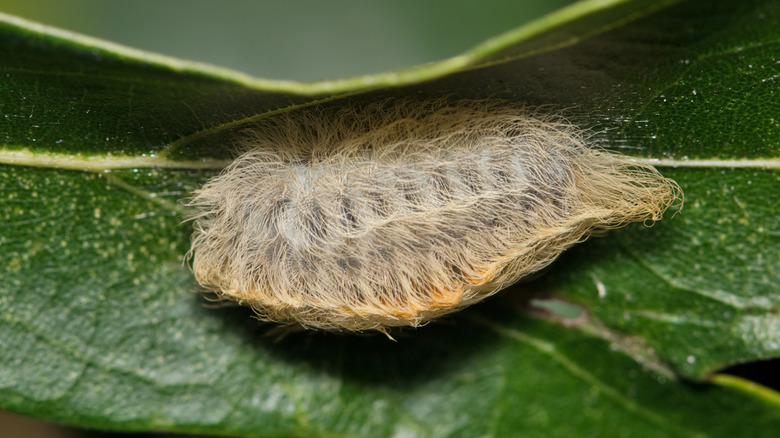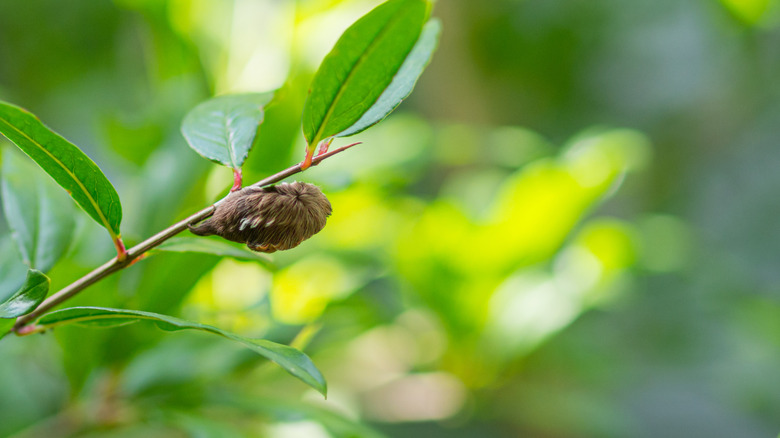The Poisonous Type Of Caterpillar That's On The Rise In Southern Texas
If you live in southern Texas, you might be used to seeing larger numbers of certain pests during the summer months. Some notable examples include mosquitoes, chiggers, fire ants, stink bugs, and fruit flies. It turns out that another species is also on the rise in the region, which can cause painful stings and potentially dangerous allergic reactions. This is none other than the deceiving furry asp caterpillar, which has an interesting appearance but is among the pesky poisonous caterpillars to watch out for in your garden.
Also called the "puss caterpillar," this is the larval stage for the southern flannel moth (Megalopyge opercularis). Unlike other types of caterpillars, the asp is covered with a thick hairy body coating called setae. In fact, you might not even recognize this as a caterpillar at all due to the fact that the setae completely covers the species with the exception of its small head that's exposed while eating. As the caterpillars reach adulthood, they retain some of these hairs in their wings, which are also mixed with flannel-like scales.
The teardrop-shaped caterpillars generally reach 1 to 1 ½ inches in length, and can be gray, yellow, red, or brownish in color. Despite its notable furry-like and seemingly harmless appearance, the asp caterpillar is among the most venomous of its kind. These are not to be confused with other types of stinging caterpillars you might find in Texas, including buck, Io, and saddleback caterpillars. Asp caterpillars are most often encountered during the spring and summer months, but they're also common in Texas during the fall months.
Why asp caterpillars can be so dangerous
Not all caterpillars are harmful, but asp caterpillars are among the types of stinging pests you might see in the garden. The majority of stinging caterpillars are larvae belonging to the flannel family of moths. These include asp caterpillars, which are particularly common in Texas. Asp caterpillars will generally keep to themselves unless they feel threatened upon contacting others. When a person touches the caterpillar, it stings and releases venom from its spine. Notably, the danger increases with larger asp caterpillars, as their stings are considered more toxic.
If you are stung, you will experience pain along with a grid-like rash along the skin right away within five minutes. Swelling is also common. Most people feel better after several hours, but it's possible to experience more severe symptoms. As the venom makes its way through the body in such cases, it's possible to have more systemic reactions, including flu-like symptoms, convulsions, and seizures. Such dangers can become even more prominent in cases where asp caterpillar populations explode, and if people encounter them unexpectedly while outdoors. The caterpillars have a preference for large oaks, elms, and smaller trees like citrus, and they can also fall out onto people who walk by.
This also isn't the first time the asp caterpillar has caused problems in Texas. In fact, two past outbreaks of the caterpillar population forced officials to shut down public schools. The first was in the San Antonio area in 1923, and the second was in Galveston a few decades later in 1951.
What to do if you see asp caterpillars around your southern Texas home
Southern flannel moths are generally known to lay eggs in trees throughout the late spring and summer months. Once the eggs hatch, asp caterpillars tend to spend time in trees and shrubs, including those around homes. You might even spot them crawling around other spots in your yard or garden. If you do spot any of these caterpillars, the best course of action is to stay away from them. Take care when working outside, and always wear gloves and long sleeves when tending to plants and trees. You should also instruct children to keep their distance from asp caterpillars, and to watch any pets that venture outdoors. Also know that once the caterpillars reach adulthood in moth form, they are no longer considered venomous.
Historically, the species are controlled at the egg stage thanks to predators such as lizards and tachinid flies. However, few predators will touch the moth at the caterpillar stage because of its venomous spine. For this reason, if you do have an issue with asp caterpillars around your southern Texas home, you might consider other methods of control. This might include working with a pest control expert to safely apply insecticides as a last resort, learning the downsides of using systemic pest control insecticides in your yard beforehand, of course. Common ingredients that may work against the caterpillars include cyfluthrin or permethrin. If you decide to use pesticides on your own, be sure to wear protective gear and carefully follow all package instructions.


